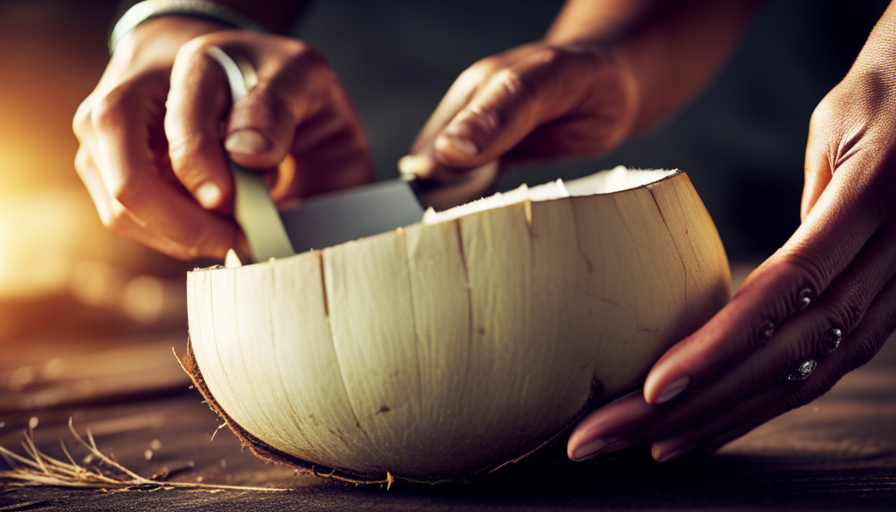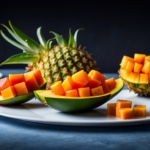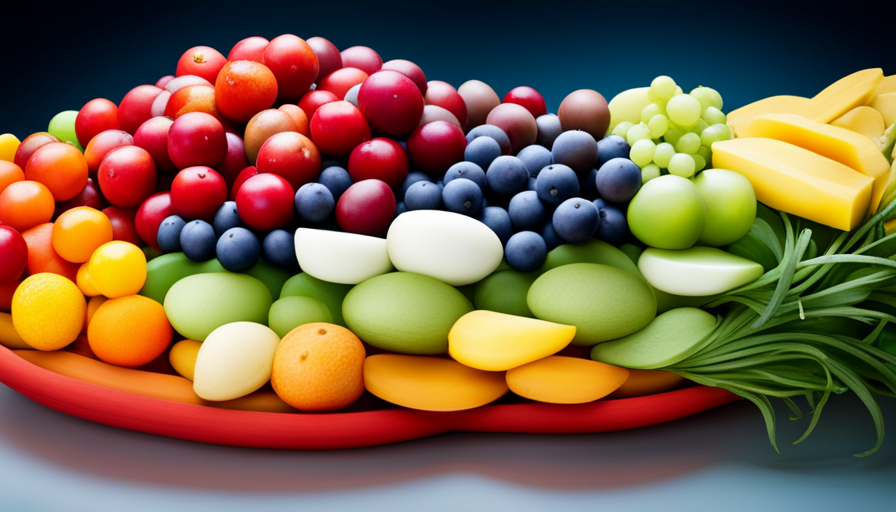Are you prepared to journey into a tropical culinary experience? Prepare yourself to explore the delicious realm of young coconuts! These delightful fruits are not only thirst-quenching and hydrating, but also provide numerous health advantages.
But before you can enjoy the creamy and sweet flesh of a young coconut, you need to know how to cut it properly. In this article, we will guide you through the process step by step, ensuring that you extract every last drop of deliciousness from this tropical treasure. From selecting the perfect coconut to separating the flesh from the shell, we’ve got you covered.
And once you’ve mastered the art of cutting a young coconut, we’ll even share some creative ways to incorporate it into your raw food recipes. So, grab your tools and get ready to unlock the mouthwatering wonders hidden within a young coconut!
Key Takeaways
- Select a ripe young coconut by checking its weight and looking for a green or yellowish-green husk.
- Proper techniques for cutting a young coconut include using a sharp chef’s knife, a sturdy cutting board, a hammer or mallet, and a bowl or container.
- Safety precautions should be taken while cutting a young coconut, such as wearing protective gloves and ensuring stability of the cutting surface.
- The soft spot on the coconut can be found by piercing the eyes on the top and pressing gently.
Selecting a Ripe Young Coconut
Now, let’s dive into the juicy world of selecting the perfect ripe young coconut just for you! When it comes to choosing a ripe young coconut, there are a few things you should keep in mind.
First and foremost, you want to make sure that the coconut is heavy for its size. This indicates that it’s full of delicious coconut water, which not only quenches your thirst but also provides numerous health benefits. Coconut water is known for its hydrating properties and is rich in essential electrolytes, making it a great natural alternative to sugary sports drinks. Additionally, young coconuts are packed with nutrients like potassium, magnesium, and vitamin C, which can boost your immune system and promote healthy digestion.
Another important factor to consider when selecting a ripe young coconut is the color of its husk. Ideally, you want to look for coconuts with a green or yellowish-green husk. This indicates that the coconut is still young and fresh. Avoid coconuts with brown husks, as this could mean that they’re overripe and the water inside may taste sour.
Now that you know the importance of selecting a ripe young coconut, you can confidently choose the perfect one for your needs. Remember, not only will you enjoy the sweet and refreshing coconut water, but you’ll also reap the many health benefits that come along with it.
So go ahead, grab that perfect ripe young coconut and savor every sip of its goodness!
Gathering the Necessary Tools
To get started, all you’ll need are a few essential tools to prepare this delicious tropical treat. Here are the items you’ll want to have on hand:
-
A sharp chef’s knife: This will be your main tool for cutting through the tough outer husk of the young coconut. Make sure it’s sharp to ensure a clean and easy cut.
-
A sturdy cutting board: Use a cutting board that won’t slip or slide while you’re working. The last thing you want is for the coconut to roll around and potentially cause an accident.
-
A hammer or mallet: This will come in handy when it’s time to crack open the coconut. You’ll use the blunt end of the hammer or mallet to tap around the circumference of the coconut to create a line of weakness.
-
A bowl or container: You’ll need something to catch the delicious coconut water that will pour out once you crack open the coconut. Make sure it’s big enough to hold all the liquid.
Now that you have all the necessary tools, it’s time to dive into the proper technique for cutting a young coconut. But before we get started, let’s go over some safety precautions to keep in mind.
Removing the Outer Husk
First things first, you’ll want to start by carefully peeling away the tough outer layer of the coconut to reveal the delicious goodness that lies within. Removing the coconut husk can be a bit tricky, but with the right techniques and tools, you’ll have it off in no time.
To remove the husk, you’ll need a few essential tools. A machete or a large knife with a sharp blade is ideal for this task. Make sure the blade is clean and sharp for easier cutting. You’ll also need a sturdy cutting board or a flat surface to work on.
To begin, hold the coconut firmly in one hand and start by making a small cut on one end of the coconut. Use a sawing motion to carefully cut through the husk, being mindful not to go too deep and cut into the inner shell. Continue this motion, rotating the coconut as you go, until you’ve gone all the way around.
Next, using the blade of the knife, pry away the husk from the inner shell. Be patient and gentle, as you don’t want to damage the coconut inside. Continue peeling away the husk until you’ve removed it completely.
With these coconut husk removal techniques and the right tools, you’ll be well on your way to enjoying the sweet and refreshing taste of a young coconut. Happy peeling!
Locating the Soft Spot
Once you’ve successfully removed the tough outer husk, it’s time to discover the hidden treasure within by locating the soft spot on the coconut. This is where you’ll find the refreshing coconut water and the tender, jelly-like meat that’s perfect for raw food recipes.
To find the soft spot, follow these steps:
- Look for the three round ‘eyes’ on the top of the coconut.
- Use a screwdriver or a sharp knife to pierce one of the eyes. This will help release the pressure inside and make it easier to locate the soft spot.
- Rotate the coconut and repeat the process with another eye.
- Once you’ve pierced two of the eyes, you should be able to find the soft spot by pressing the coconut gently. It should feel slightly softer and give a little when you apply pressure.
Finding the best young coconuts is essential for a delicious raw food experience. Look for coconuts that have a good amount of water inside and a firm, yet slightly yielding meat. Understanding the different stages of ripeness is also important. Young coconuts are usually green and have the most water content. As they ripen, they turn brown and the water decreases while the meat becomes thicker and more gelatinous. So, if you prefer a sweeter taste and thicker meat, opt for coconuts that are more brown in color.
With the soft spot located, you’re now ready to open your young coconut and enjoy its refreshing water and tender meat.
Opening the Coconut
Cracking open the coconut reveals a hidden world of refreshing water and tender meat. Opening a young coconut is a simple yet rewarding process. Once you’ve located the soft spot, it’s time to dive in and enjoy the delicious goodness that awaits you.
To open the coconut, you’ll need a sturdy knife or a cleaver. Hold the coconut firmly in one hand and position the knife at a 45-degree angle towards the soft spot. With a swift and confident motion, bring the knife down, applying enough force to crack the shell open. Be careful not to hit your hand or fingers!
Once the coconut is cracked open, you’ll be greeted by the sweet aroma of coconut water. This liquid is not only incredibly refreshing but also packed with numerous health benefits. Coconut water is naturally hydrating and rich in electrolytes, making it an excellent choice for replenishing your body after physical activity. It’s also low in calories and fat, making it a guilt-free treat.
Inside the coconut, you’ll find the tender meat, which can be enjoyed as is or used in various dishes. The meat is not only delicious but also a great source of healthy fats, fiber, and essential minerals.
So go ahead and open that coconut to enjoy the delightful combination of coconut water benefits and the health benefits of young coconut meat. It’s a truly refreshing and nourishing experience!
Draining the Coconut Water
To drain the water from the coconut, simply hold it firmly and position the knife at a 45-degree angle towards the soft spot, then with a swift motion, bring the knife down to crack it open, revealing the refreshing coconut water. Did you know that on average, a young coconut contains about 200 to 1000 milliliters of water?
Coconut water is not only delicious, but it also offers numerous health benefits. Packed with electrolytes, it’s a natural way to stay hydrated. It replenishes your body with essential minerals like potassium, magnesium, and calcium, which are crucial for maintaining a healthy balance. Additionally, coconut water is low in calories and fat, making it a perfect choice for those watching their weight.
Aside from being a tasty beverage, coconut water has alternative uses as well. Many people use it as a base for smoothies or as a natural sports drink. Its natural sweetness makes it a great addition to fruit juices or cocktails. Furthermore, coconut water can be used as a natural remedy for hangovers due to its hydrating properties.
So, the next time you crack open a young coconut, remember that not only are you enjoying a refreshing drink, but you’re also benefiting from its natural electrolytes and exploring its alternative uses. Cheers to the versatile and healthy coconut water!
Separating the Flesh from the Shell
When you firmly grasp the coconut and tilt it sideways, the sweet, creamy flesh will easily separate from the hard, brown shell. It’s important to know the proper techniques for separating the flesh to ensure you preserve its freshness. Here’s how to do it:
- Hold the coconut over a bowl to catch any dripping coconut water.
- Use a sturdy knife or a coconut scraper to carefully pry the flesh away from the shell. Start at one end and gently work your way around.
- Apply a bit of pressure as you go, but be careful not to dig too deep to avoid cutting into the shell and mixing it with the flesh.
- Continue until the entire flesh is separated from the shell, leaving you with a smooth, white mound of coconut goodness.
As you separate the flesh, you’ll notice its smooth texture and rich aroma filling the air. This process not only releases the delicious flesh but also helps to preserve its freshness. By keeping the flesh separate from the shell, you prevent any moisture or bacteria from affecting its taste and quality. So, take your time and enjoy the experience of separating the young coconut flesh, knowing that you’re preserving its natural goodness for a delectable raw food treat.
Storing the Coconut Water and Flesh
Now that you’ve successfully separated the flesh from the shell of the young coconut, let’s talk about how to store the precious coconut water and delicious flesh.
When it comes to storing the coconut water, it’s best to transfer it into an airtight container and refrigerate it. This will help preserve its freshness and prevent any unwanted bacteria from forming. Coconut water isn’t just incredibly refreshing, but it’s also packed with electrolytes, making it a perfect natural sports drink or a hydrating beverage on a hot day.
As for the coconut flesh, you have a few options for storing it. If you plan on using it within a day or two, you can simply place it in a tightly sealed container and keep it in the refrigerator. However, if you want to extend its shelf life, you can freeze the flesh. Cut it into small pieces, place them in a freezer bag, and pop it in the freezer. This way, you can enjoy the sweet and creamy flesh for weeks to come.
By storing the coconut water and flesh properly, you can ensure that you have a refreshing and healthy treat available whenever you crave it. So, go ahead and savor the tropical goodness while reaping the numerous health benefits these young coconuts offer.
Enjoying the Coconut Flesh
Indulge in the creamy, tropical goodness of the coconut flesh and relish the health benefits it brings. Here are four ways you can enjoy the coconut flesh:
-
Coconut Smoothie: Blend the coconut flesh with your favorite fruits, such as mango or pineapple, and a splash of coconut water for a refreshing and nutritious smoothie. The rich and velvety texture of the coconut flesh adds a luscious creaminess to your drink.
-
Coconut Chia Pudding: Combine the coconut flesh with chia seeds, coconut milk, and a touch of sweetener. Let it sit in the refrigerator overnight, and wake up to a creamy and satisfying chia pudding. Top it with fresh berries or nuts for added crunch.
-
Fresh Coconut Sorbet: Freeze the coconut flesh and blend it with a little coconut water until smooth. The result is a heavenly coconut sorbet that is both cooling and bursting with tropical flavors.
-
Coconut Yogurt Topping: Sprinkle shredded coconut flesh on top of your favorite dairy-free coconut yogurt. It adds a delightful chewiness and enhances the overall taste of your yogurt.
Whether you’re craving a creamy smoothie or a luscious chia pudding, the versatile coconut flesh is a perfect ingredient to create a range of delicious and healthy treats. Enjoy the tropical goodness!
Creative Ways to Use Coconut in Raw Food Recipes
Try blending shredded coconut flesh with dates and nuts to create a deliciously chewy and nutty snack bar. This simple recipe is a great way to incorporate coconut into your raw food diet. Not only does it taste amazing, but it also provides a good source of healthy fats and natural sweetness.
Another creative way to use coconut in raw food recipes is by making homemade coconut milk. Simply blend fresh coconut meat with water, strain it, and you’ve got a creamy and nutritious milk alternative. Coconut milk can be used in a variety of dishes, from smoothies to curries, adding a rich and tropical flavor.
Coconut water, the liquid found inside young coconuts, is another ingredient that can be used in raw food recipes. It’s not only refreshing but also packed with electrolytes and natural sugars, making it a great natural sports drink. You can use coconut water as a base for smoothies, juices, or even freeze it into ice cubes for a refreshing twist.
Incorporating coconut into your raw food recipes not only adds flavor and texture but also provides numerous health benefits. So, get creative and start exploring the endless possibilities of using coconut in your raw food creations. From coconut milk recipes to coconut water benefits, there are plenty of ways to enjoy the goodness of this tropical fruit.
Frequently Asked Questions
Can I use any type of knife to open a young coconut?
Yes, you can use any type of knife to open a young coconut, but it’s important to choose the right one for the job. A cleaver or a chef’s knife with a sharp, sturdy blade would work best.
To safely open a young coconut, start by piercing the soft spots on the top with the tip of the knife. Then, use a twisting motion to create a larger hole.
Be careful and take your time to avoid any accidents.
How long can I store the coconut water and flesh in the refrigerator?
You can store coconut water in the refrigerator for up to a week. Make sure to transfer it to an airtight container to keep it fresh.
As for the coconut flesh, it can be preserved by placing it in a sealed bag or container and storing it in the refrigerator for up to four days. This will help maintain its taste and texture.
Enjoy the refreshing coconut water and delicious flesh for several days!
Can I use the coconut water in smoothies or other recipes?
Yes, you can definitely use coconut water in smoothies and other recipes. Coconut water adds a refreshing and tropical flavor to your creations, making them even more delicious. It can be used as a base for smoothies, mixed into juices, or even used in cocktails for a unique twist.
Additionally, coconut water can be used to make popsicles, sorbets, or as a hydrating ingredient in baking. The possibilities are endless when it comes to alternative uses for coconut water in recipes.
Are there any health benefits to consuming young coconut?
There are numerous health benefits to consuming young coconut. Packed with essential nutrients and electrolytes, it’s a great source of hydration. The coconut water found inside isn’t just refreshing but also low in calories and high in potassium, making it an ideal choice for replenishing your body after a workout.
Additionally, young coconut meat is rich in fiber, healthy fats, and vitamins, promoting digestion and boosting your immune system.
Is there a specific season when young coconuts are more readily available?
Young coconuts are most readily available during specific seasons, making them a seasonal treat. To open a young coconut, you’ll need a sharp knife with a pointed tip. Carefully pierce the coconut’s soft eye, then drain the refreshing coconut water into a container.
Next, firmly strike the coconut’s outer shell to crack it open. Store the remaining coconut water and flesh in the refrigerator for up to a week. You can use the coconut water in smoothies and recipes to enjoy its health benefits.
Can Lentils Be Incorporated into a Raw Food Diet that Includes Young Coconut?
Yes, eating lentils raw food diet can be incorporated into a raw food diet that includes young coconut. Lentils can be sprouted and added to salads or blended into raw soups for a nutritious boost. They offer a great source of plant-based protein and can add variety to a raw food diet.
Conclusion
Now that you know how to cut a young coconut, the possibilities are endless! Imagine indulging in the creamy, refreshing flesh of this tropical delight.
Whether you blend it into smoothies, sprinkle it over salads, or use it as a base for raw food recipes, the taste will transport you to paradise. But wait, there’s more!
Unlocking the secrets of the young coconut opens up a world of creative culinary exploration. So, what are you waiting for? Grab your tools and embark on this delicious adventure today. You won’t be disappointed!

















